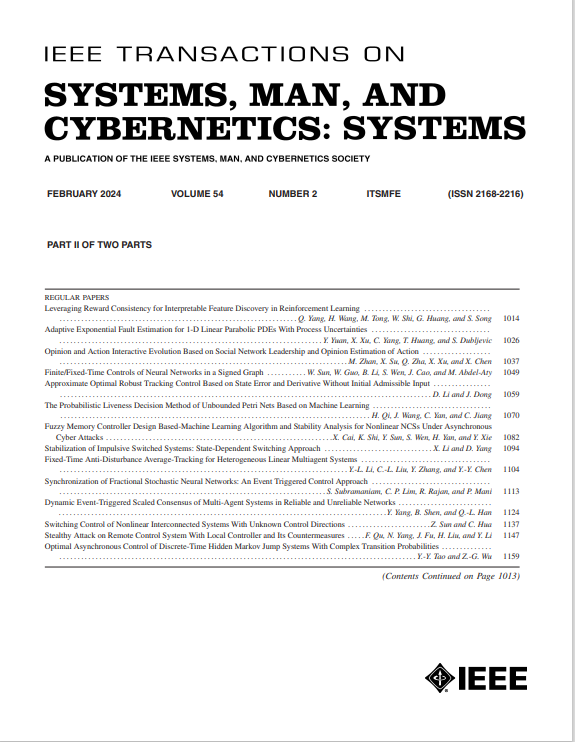切换延迟神经网络同步的耗散分析与无碰撞传递控制:一种改进的组合切换方法
IF 8.7
1区 计算机科学
Q1 AUTOMATION & CONTROL SYSTEMS
IEEE Transactions on Systems Man Cybernetics-Systems
Pub Date : 2025-08-15
DOI:10.1109/TSMC.2025.3593877
引用次数: 0
摘要
本文主要研究了交换延迟神经网络(sdn)的耗散分析和无碰撞传输同步问题。为了有效地利用系统状态的过去信息,创造性地建立了一种改进的组合交换方法,为sdn的耗散分析提供了一个更保守的框架。通过构造一个新的时变多重Lyapunov-Krasovskii泛函(TDMLF),给出了确保所考虑的sdn具有严格的$(\mathscr {X}_{1}, \mathscr {X}_{2},\mathscr {X}_{3})$ - $\gamma $耗散性的充分条件,即使在所有子网都是非耗散的情况下也是如此。随后,将该方法用于sdn的同步,其中首先采用无碰撞传输类比例积分(PI-like)控制方法。此外,还提出了相应的判据,保证闭环同步误差系统(SESs)不仅满足严格的耗散性,而且具有一定的无碰撞传输性能。最后,通过两个仿真算例充分验证了所提设计方法的实用性和优越性。本文章由计算机程序翻译,如有差异,请以英文原文为准。
Dissipativity Analysis and Bumpless Transfer Control for Synchronization of Switched Delayed Neural Networks: A Modified Combined Switching Approach
This investigation mainly focuses on the dissipativity analysis and bumpless transfer synchronization issue for switched delayed neural networks (SDNNs). To effectively leverage the past information of system states, a modified combined switching approach is creatively established, which offers a less conservative framework for the dissipativity analysis of SDNNs. By constructing a new time-dependent multiple Lyapunov–Krasovskii functional (TDMLF), sufficient conditions are then developed to ensure the strict $(\mathscr {X}_{1}, \mathscr {X}_{2},\mathscr {X}_{3})$ - $\gamma $ dissipativity for the considered SDNNs, even in cases where all subnetworks are nondissipative. Subsequently, the proposed approach is implemented for the synchronization of SDNNs, where a bumpless transfer proportional-integral-like (PI-like) control approach is first adopted. In addition, the corresponding criterion is also proposed, which guarantees that the resultant closed-loop synchronization error systems (SESs) not only satisfy strict dissipativity but also achieve a certain bumpless transfer performance (BTP). Ultimately, the practicability and superiority of the proposed design approach are thoroughly substantiated through two simulation examples.
求助全文
通过发布文献求助,成功后即可免费获取论文全文。
去求助
来源期刊

IEEE Transactions on Systems Man Cybernetics-Systems
AUTOMATION & CONTROL SYSTEMS-COMPUTER SCIENCE, CYBERNETICS
CiteScore
18.50
自引率
11.50%
发文量
812
审稿时长
6 months
期刊介绍:
The IEEE Transactions on Systems, Man, and Cybernetics: Systems encompasses the fields of systems engineering, covering issue formulation, analysis, and modeling throughout the systems engineering lifecycle phases. It addresses decision-making, issue interpretation, systems management, processes, and various methods such as optimization, modeling, and simulation in the development and deployment of large systems.
 求助内容:
求助内容: 应助结果提醒方式:
应助结果提醒方式:


